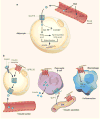Diabetes: The good in fat
- PMID: 25409152
- PMCID: PMC4429762
- DOI: 10.1038/nature14070
Diabetes: The good in fat
Abstract
A new class of fatty acid — found in food and synthesized by mammalian tissues — enhances glucose uptake from the blood and reduces inflammation, suggesting that these fats might be used to treat diabetes.
Figures

Comment on
-
Discovery of a class of endogenous mammalian lipids with anti-diabetic and anti-inflammatory effects.Cell. 2014 Oct 9;159(2):318-32. doi: 10.1016/j.cell.2014.09.035. Cell. 2014. PMID: 25303528 Free PMC article.
References
Publication types
MeSH terms
Substances
Grants and funding
LinkOut - more resources
Full Text Sources
Other Literature Sources

